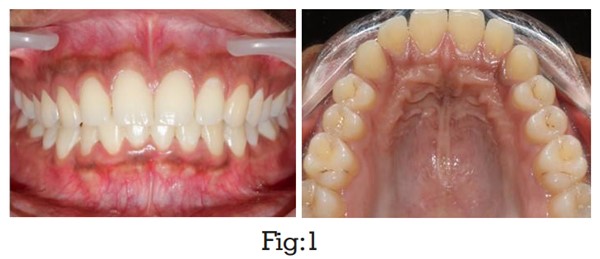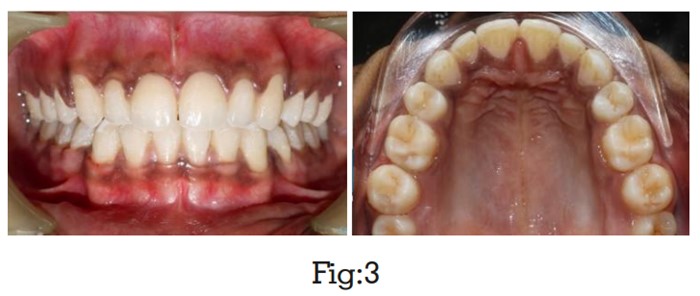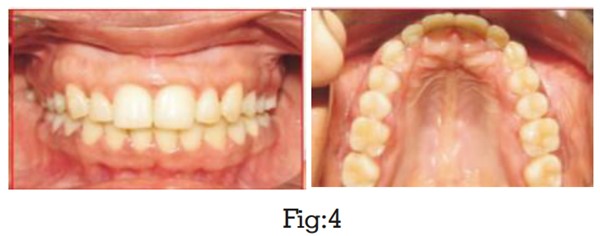

Nowadays, aesthetic treatments are more and more in demand as people’s concerns about their appearance, particularly in the dental industry, have grown. Various principles of a pleasing smile have been put forth by numerous authors, along with guidelines for the ideal structure of the face and teeth. Recently, ideas like Visagism have been combined with these parameters. It places emphasis on the individuality and beauty of each person. It is an art that focuses on developing a unique personal brand that is in tune with aesthetics and each person’s personality and lifestyle.
Key words: Visagism, smile design, personality characteristics
Smile is the emotion of joy, wonder, and celebration. It is the manifestation of inner tranquillity,
certainty, joy, and contentment. How effectively a
person can interact with others in society is frequently influenced by their capacity to express a
wide range of emotions through the shape and
movement of their lips and teeth. An attractive or pleasing smile definitely increases a person’s
acceptance in the society to which they belong,
and the smile’s characteristics greatly affect a
person’s attractiveness and personality.
As people’s concerns about their appearance
have grown, particularly in the dental field, aesthetic treatments are becoming more and more
popular today. Various parameters for the ideal
composition of the facial and dental structures
have been offered by a number of authors. Recently, ideas like visagism have been combined
with these parameters.1
Visagism places a strong emphasis on the individuality and beauty of each and every person.
It is an art that focuses on developing a unique
image that is in tune with aesthetics and each
person’s personality and lifestyle.
The term “visagism” was first used in 1936 by
legendary hairdresser and makeup artist Fernaund Aubry (1907-1976), and it is derived from
the French word “visage,” which means “face.”
He never wrote a book or defined the concept visagism. There were only a few snatches of his
makeup lessons or phrases, illustrating the idea
that a beauty expert should express a person’s
personality rather than fashion, for a harmonious and aesthetically pleasing appearance.
Later, a plastic artist named Phillip Hallawel developed and precisely defined this idea. He is the
author of the first book in this concept, “Visagismo: Harmony and Esthetics.” Visagism entails
the development of a personalized image that
conveys a person’s identity. The approach taken
to put this idea into practice is derived from the
relationship between the fundamentals of artistic
visual language and fields like psychology, neurobiology, anthropology, and sociology. Through
the use of visagism, it is now possible to identify
the emotions and personality traits that patients
want to convey through their outward appearance, specifically through their smile. Clinicians
can create a smile using the visagism concept
that combines the patient’s physical attributes,
personality, and desires.
Brazilian dentist Dr. Braulio Paolucci is credited
with being the first to use the visagism concept
in dentistry. He masterfully combines traditional and contemporary ideas from anthropology,
psychology, and the visual arts, incorporating
them into the design of the patient’s smile. He
worked so that he could involve the patient in the
procedure by having a candid discussion about
the significance of the characteristics that make
up their smile. Given that the patient can take
part in the planning of his smile design with visagism, the professional can be more certain of
the treatment’s outcome.
The Pincus silhouette, which is formed by the
region of light reflection between the cusps of
reflection of mesial, distal, cervical, and incisal
aspect, defines the shapes of the anterior teeth.
A number of reference lines, like the connecting the gingival zeniths, incisal embrasures, gingival papillae, and incisal plane are considered.
Since these lines are archetypical symbols, different combinations of their elements will cause
the observer to experience various emotions.
The four basic tooth shapes are rectangular, triangular, oval, and square, with some variations.
Natural tooth shapes are also a variety of interactions between vertical, horizontal, inclined,
straight, and curved lines. The following categories can be used to categorize these lines emotional significance and powers of expression:
These basic formats are followed by dental
arches also.3
These lines are combined to create the most
fundamental forms or shapes, each of which reflects a different expression. The square symbolizes stability and immobility due to the inherent
balance between the vertical and horizontal elements in this shape, while the triangle evokes
dynamism, the oval conveys a sense of delicacy, and the vertical rectangle expresses strength
through the predominance of the vertical element on the horizontal.1
Temperaments are for acquiring a thorough understanding of more assertive and aligned image of who the person is, their moments of life,
and their intention, rather than using temperaments to categorize people. Every temperament
has distinctive qualities that the individual frequently wants to emphasize.(2)
Four temperaments, shape of face and teeth in
relation to it are given below:
Choleric/strong: This kind of person has deepset eyes, a rectangular face with sharp angles,
and horizontal and vertical lines around the
mouth and forehead. Strong leadership abilities, decisiveness, daring, and fearlessness
characterize their personality.
The maxillary anterior teeth are arranged with
their long axes parallel to the horizontal plane,
the visually-dominant rectangular central incisors are vertical, and the canines are positioned
vertically. Radial symmetry can be seen in the
choleric/strong design. While the gingival zeniths connection lines run horizontally from canine to canine with the lateral incisors below
them, the embrasures connection lines run vertically between the central and lateral incisors.
Generally speaking, the maxillary arch is rectangular (Fig:1)

Sanguine/dynamic: A prominent nose, a wide
mouth, and slanting lines around the eyes and
forehead give this type of person an angular
face. They are extroverted, talkative, and very
active.
The maxillary anterior teeth in this pattern are
positioned with their long axes slightly angled
distally and with discreet radial symmetry. The
connection lines of the embrasures and the incisal plane are ascendant from the medial line, and the connection lines of the zeniths are ascendant or in a zigzag pattern. The labial aspect
of the canines is straight and palatally inclined,
and the central incisors are typically triangular
or trapezoidal. Most of the maxillary arch is triangular or polygonal in shape. (Fig.2)

Melancholic/sensitive: These people have oval
faces with rounded or thinly defined features,
close-set eyes, and an oval face. The gentleness,
awareness, and capacity for abstract thought
characterize the melancholic/sensitive personality.
The maxillary anterior teeth in this pattern have
discrete radial symmetry and either rectilinear
or distally inclined long axes. An inverted incisal
plane is produced when the connection lines of
the zeniths and embrasures descend from the
medial line. The labial aspect of the canines is
curved and inclined medially, whereas the central incisors typically have an oval shape. Most
of the maxillary arch is oval. (Fig:3)

Phlegmatic/peaceful: They are gentle, discreet,
and diplomatic, with a round or square face, outwardly projecting lower lips, and heavy eyelids.
Except for the canine, which may be slightly rotated sideways, the maxillary anterior teeth in
this arrangement all have long axes that are perpendicular to the horizontal plane. No tooth
group has the upper hand. There is horizontal
symmetry, typically with a diastema in a broad
arch. Both the gingival zenith connection line
and the embrasure connection line are straight.
The labial aspect of the canines is curved and
vertically positioned, whereas the central incisors are typically square and small. Usually has
a circular maxillary arch.3
(Fig: 4)

In aesthetic dentistry, the visagism concept
is used to assess the facial type. This involves
making subjective decisions, spending time on
personality tests, and performing intricate calculations on the teeth configuration. The numerical
results must then be represented graphically as
a set of teeth that will benefit the patient, the dentist, and the dental laboratory. These procedures
make it challenging and error-prone for dentists
to apply the concept. The solution is to create a
software program that does all the calculations
automatically, eliminates subjective judgment,
and displays the ideal tooth configuration in a
matter of minutes.
There are many high-quality DSD (Digital Smile
Design) software products available on the
market, including Planmeca Romexis® Smile
Design, Smile Designer Pro, and DSD 2D.
However, the visagism concept, which creates
a smile design in relation to the patient’s facial
type and personality and is perceived as more
harmonious, is not used in these solutions. A
software program called VisagiSMile automates
the process of developing dental visagism cases. VisagiSMile is a multiplatform web application for cosmetic dentistry that can be accessed immediately after completing a brief registration
process. To enable dentists to work on various
hardware and software platforms, including
computers, tablets, and smartphones, all cases
and data are stored on a server. The investigation into the Visagism software is a continuous
process that constantly require changes.
By continuously delivering a usable software
product, VisagiSMile is developed in accordance
with the principles of agile software development. Every few weeks, the application receives
an update that introduces a new version. While
utilizing the new features, all users continue to
use their accounts and data as before. There are
seven steps involved in creating a dental visagism case with VisagiSMile. They are as follows:
For achieving predictable aesthetic results, combining contemporary digital technologies with
traditional treatment guidelines can be helpful.
Visagism is a concept that can be used to produce smiles that are more genuine and unique.
This idea assumes that the patient’s identity and
the smile’s design are in perfect harmony. However, due to the lack of an objective method for
analysing personality and its application to designing smiles, its use in dentistry is limited.